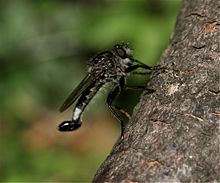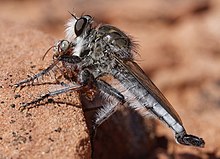Efferia
Small to large-sized robber flies (10–40 mm) with distinctly different shape of the posterior end of the abdomen in males versus females.
Males have a "helicopter tail" with glossy black claspers that are covered in hairs, forming part of a complex genital structure (the combined epandrium and hypandrium) that is clearly larger than the abdominal segments and is oriented diagonally to vertically upwards relative to the main body axis.
Venation includes a recurrent vein on R1, narrow cell r4, R4 extending roughly parallel to R5 or converging moderately with R5 towards the wing tip.
Prey are taken from a wide variety of insect orders: Robert Lavigne's Predator-Prey Database for the family Asilidae[1] has 918 records for Efferia species feeding frequently on Diptera, Homoptera, Hymenoptera, Heteroptera, Coleoptera, Lepidoptera, Orthoptera, as well as a few reports of prey species belonging to Neuroptera, Odonata, Ephemeroptera - and even one record for Araneae (spiders).
This is especially true for the males, which emit a characteristic pulsing buzz during the few seconds in flight; this sound tends to be loud and noticeably higher pitched than that of a flying female.






